telegraphic codes and message practice
scanned code directory
government and colonial administration codes
Gathered here are descriptions and specimen pages of government telegraphic codes; two of them were used in colonial administration. I have excluded military, meteorological and public health codes, as well as diplomatic codes.
Click on the year of publication, to be taken to discussion of that code.
1903 Word Code for Foreign State Telegrams (India; Part II, Code phrase)
1911 New Zealand Government Telegraph Code
1933 U.K. Government Telegraph Code, 1933
overview
This is a new page, created on 3 October 2018. I expect to make revisions and additions in coming days and weeks.
In their phrase selections, these codes reflect the political and administrative complexities of those realms in which they were used. This is most strikingly on display in the India Word Code. In a sense, they are a-historical abstractions from the circumstances in which they were used: context is absent, only fragmentary language is presented (albeit in an orderly fashion).
aside —
I have drawn some poetical derivations from two of these codes, and posted them at my separate asfaltics blog. These are, respectively, from
the Word Code for Foreign State Telegrams (1903), here, and
from an appendix to the 1933 Government Telegraph Code, here.
| 1903 | Word Code for Foreign State Telegrams,
Compiled for the Government of India (Part II.—Code Phrase.) by J. H. Lane, Indian Government Telegraph Department. Fourth Edition, prepared at the India Office, London, under the direction of J. J. Allen, Indian Government Telegraph Department, Retired. | London, n.d. (elsewhere dated 1904; internal printing information (small type at bottom of prelim pages) states 11/1903 and 6/1903) | private collection, and
Rajasthan University copy at archive.org different copy/scan (with pasted-in revisions), also via archive.org |
I have owned a copy of this code for years, and neglected it. The reason: it is organized alphabetically, by codeword, and is thus usable only for decoding, not coding. Its phrases are random. The more interesting volume, I thought, would be Part I, in which phrase elements would presumably be organized in a mix of alphabetical, onomasiological (thesauric) and tabular orders. My copy of Part II was not interesting enough, I thought.
And yet. Close inspection of this volume, in search of the makings of poetic derivations, suggests to me that Part I could be generated out of Part II. Slow trawling through its pages does give a sense of the habitus in which it was used.
Among the topics and categories that appear are these (in no order) :
references to revenue and ordinary despatches, and telegrams (and dates of sending); current values of government securities; dates (of the year, and calendar and fiscal years); movements of troops; promotions and pensions; legal proceedings (including sentencings); departures and arrivals; public works; public health (including epidemics and the like); floods; political dealings with native notables; public order (riots, unrest, etc.). Here also are phrases — about discretion, or embarrassment, or dilemmas, ambiguities, indignities, perplexity, etiquette — that are not often found in other codes.
I will provide examples indicating this range of topics, soon.
Some specimen pages are shown below.
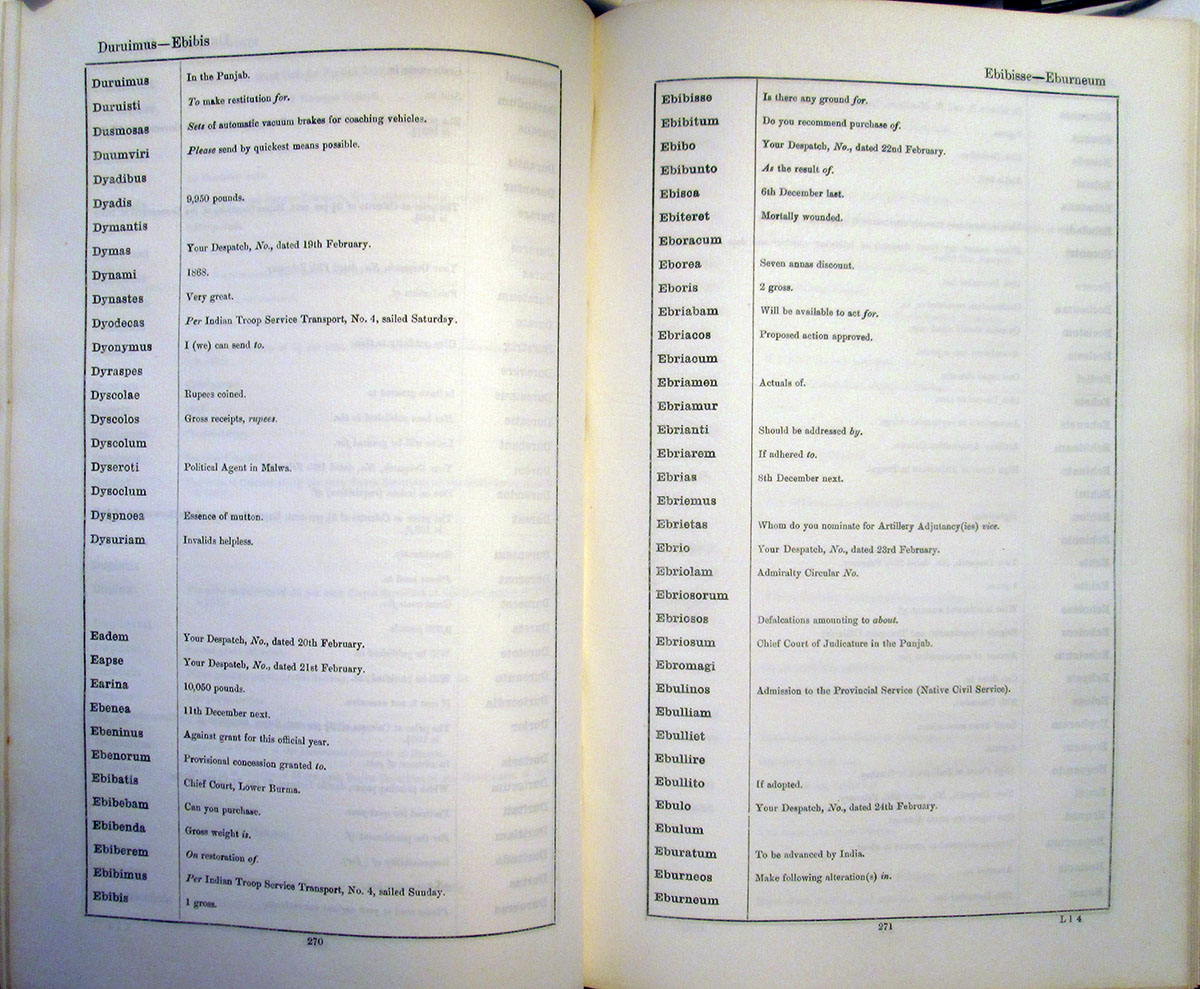 |
|
| pages 270-271 Word Code for Foreign State Telegrams, Compiled for the Government of India (Part II.—Code Phrase.) (1903) |
private collection |
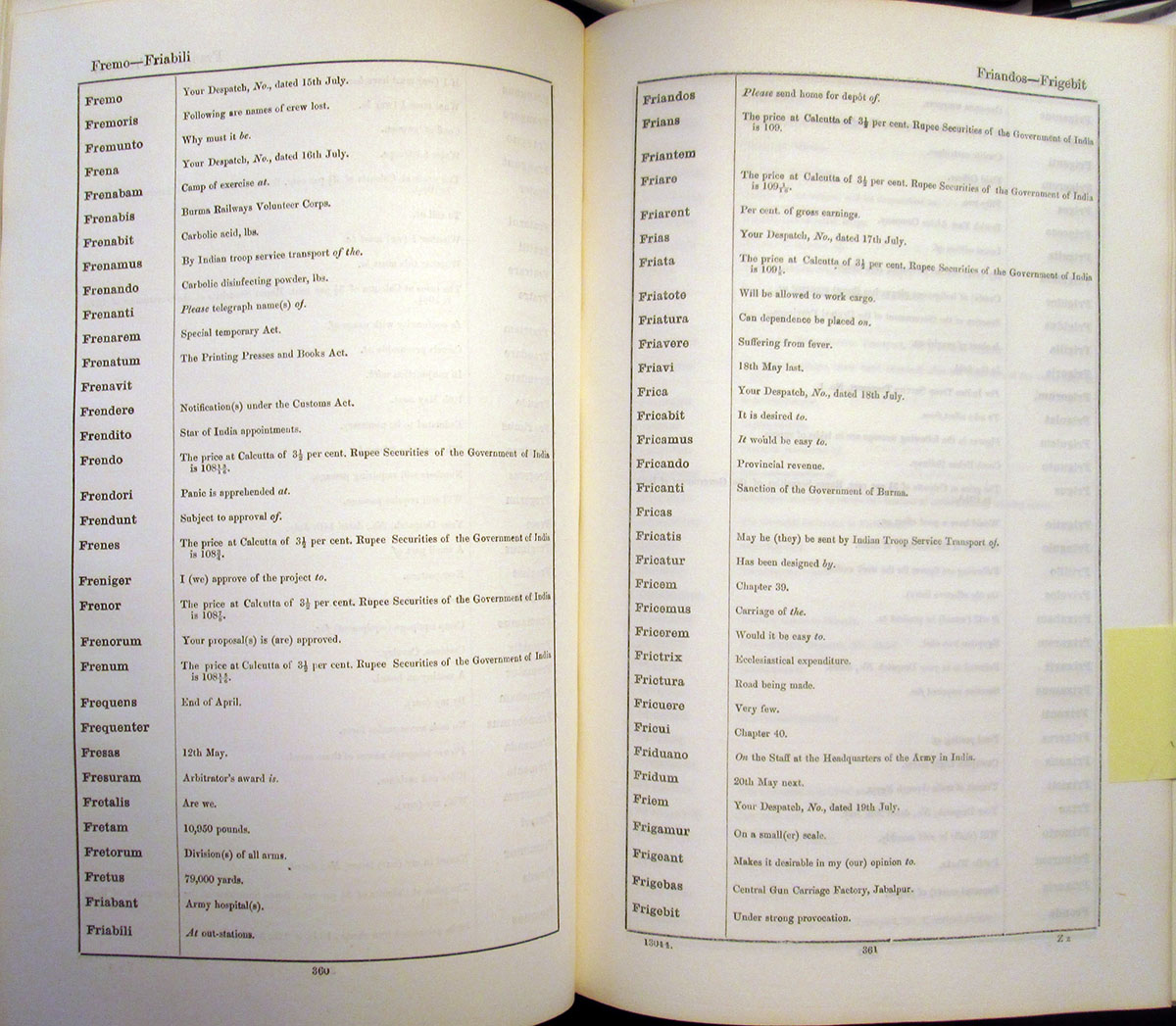 |
|
| pages 360-361 Word Code for Foreign State Telegrams, Compiled for the Government of India (Part II.—Code Phrase.) (1903) |
private collection |
 |
|
| pages 696-697 Word Code for Foreign State Telegrams, Compiled for the Government of India (Part II.—Code Phrase.) (1903) |
private collection |
| 1911 | New Zealand Government Telegraph Code for use of Ministers, High Commissioner, and Treasury New and revised edition, 1911 | compiled by James B. Heywood, I.S.O., New Zealand Civil Service Wellington:John Mackay, Government Printer | private collection New Zealand National Library record |
| 1,161 pages, containing nearly 70,000 codewords (and their respective phrases or tabular elements).
Codewords are taken directly from the New Official Vocabulary (four volumes, 1899-1901) — Aabam, Aaboras, Aachenense, Aacia, and so on. (Click here to for google scan of first page of first volume (of four) of the Offical Vocabulary, to open in separate tab or window.) These multi-syllabic (for built-in redundancy) codewords would soon be giving way to five-letter codes. Each codeword is twinned with a figure, so that the code might be used with the figure-to-safe-letter condensers of the time. |
|||
The code is divided into sections for figures and amounts, general sentences (phrases), and then shorter sections for defence materials, and industries/commodities. A more detailed description is provided by Rob Laking —
- Pages 2-54 are devoted to Numerals, Fractions and Whole Numbers, giving code substitutions for currency amounts (Pounds, Shillings and Pence “which can be used to denote any other Currency, or Weight, or Measure”) up to 46,000,000.
- The main part of the Code (pages 56-1100) is General Sentences, single words or phrases that can be combined into sentence form.
- Pages 1102-1103 are Defence Material, including Rifles, Guns, Explosives, Cartridges and Projectiles. These are arranged in a Table: the rows are the stores items, and the four columns are for procurement and shipment to each of Auckland, Dunedin, Lyttelton and Wellington. Example: the code word Retrolego stands for “Procure and ship to Lyttelton by direct steamer: projectiles for 12-pounder Q.F. guns shells filled common pointed”, obviously with a further code word for the quantity required.
- Pages 1106-1136 are for Industries and Commerce and are for market conditions and prices for a range of commodities, including Beans, Beef, Butter, Cheese, Cocksfoot Grass Seed, Hemp, Kauri Gum, Lamb, Mutton, Oats, Peas, Potatoes, Wheat and Wool. Broadly speaking, the entries are either descriptions of market conditions, or specific quotations of prices, or sometimes both. Examples: Reverist stands for “Buyers of butter express dissatisfaction with New Zealand butter this season”; while Revibrabas means “the average price of choicest New Zealand butter today is 101/- [101 shillings]”.
- The remainder of the Code covers stores for Post and Telegraph (1138-1139), Printing and Stationery (1142-1152), and Railway and Public Works (1154-1161) organised similarly to the Defence Stores: rows with items and columns with procurement and shipping instructions.
The Preface, and Specimen pages are shown below
 |
|
| preface, New Zealand Government Telegraph Code (1911) |
RL |
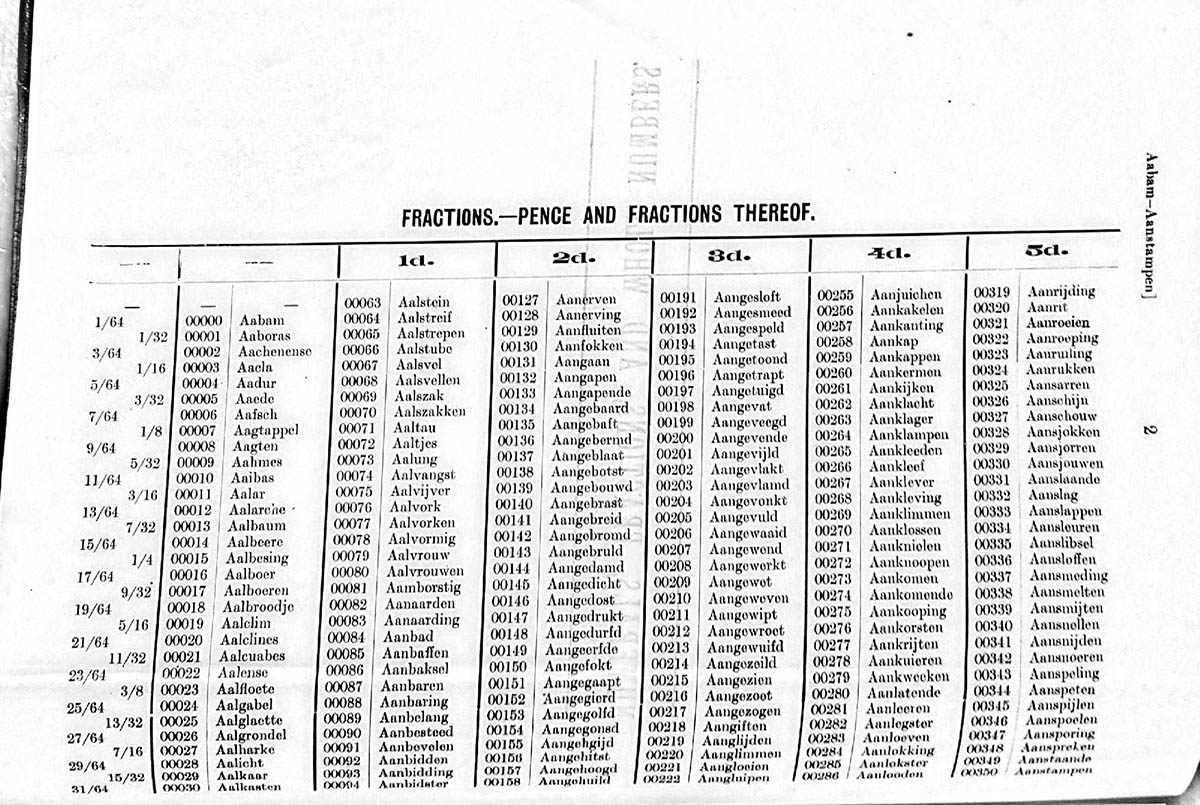 |
|
| page 2, New Zealand Government Telegraph Code (1911) |
RL |
Use of this code would rely — as is always the case to some degree — on the judgement of the coding officer or clerk, in choosing for example from synonyms offered with the "catch" word.
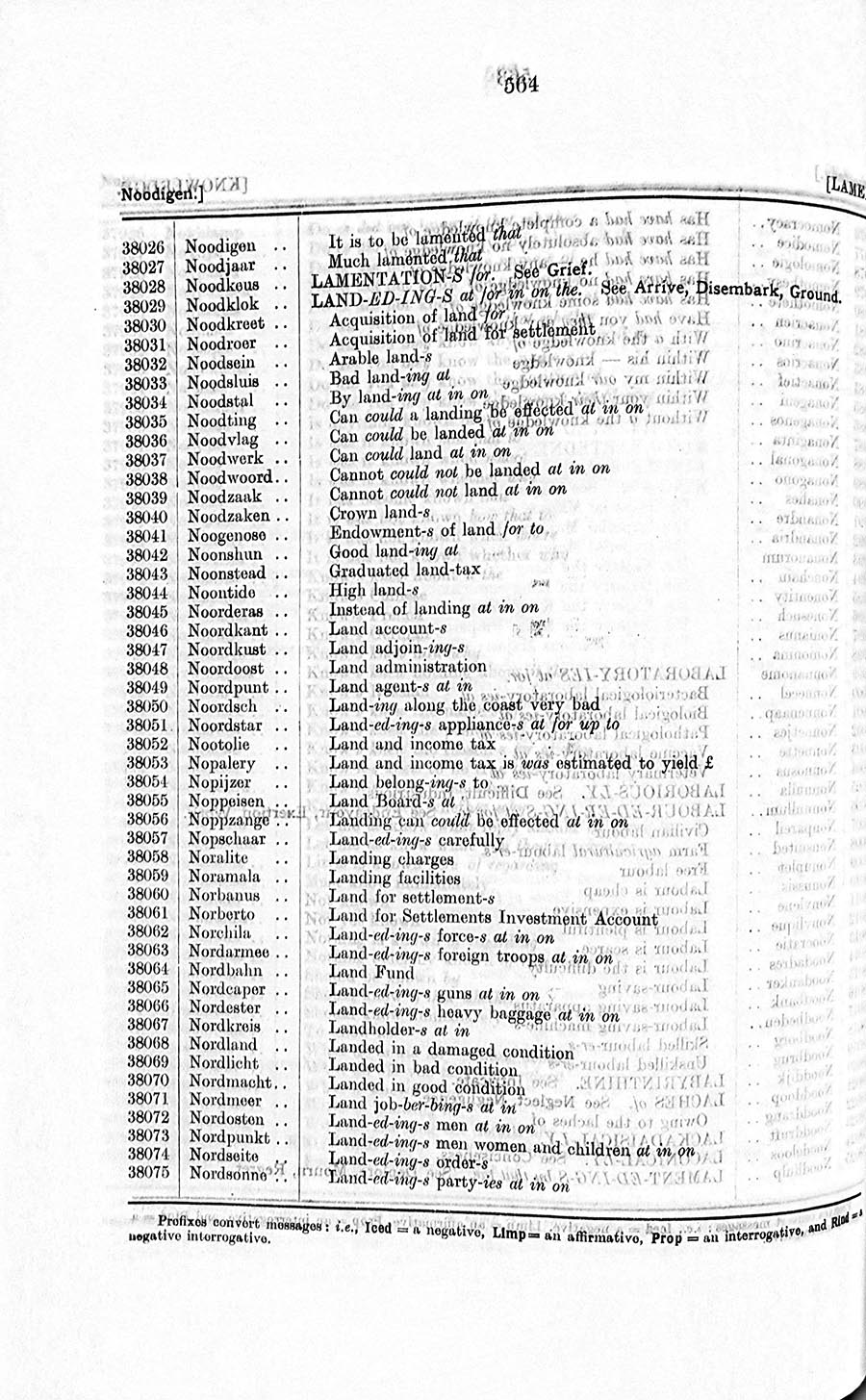 |
|
| page 564, New Zealand Government Telegraph Code (1911) |
RL |
 |
|
| page 1102, New Zealand Government Telegraph Code (1911) |
RL |
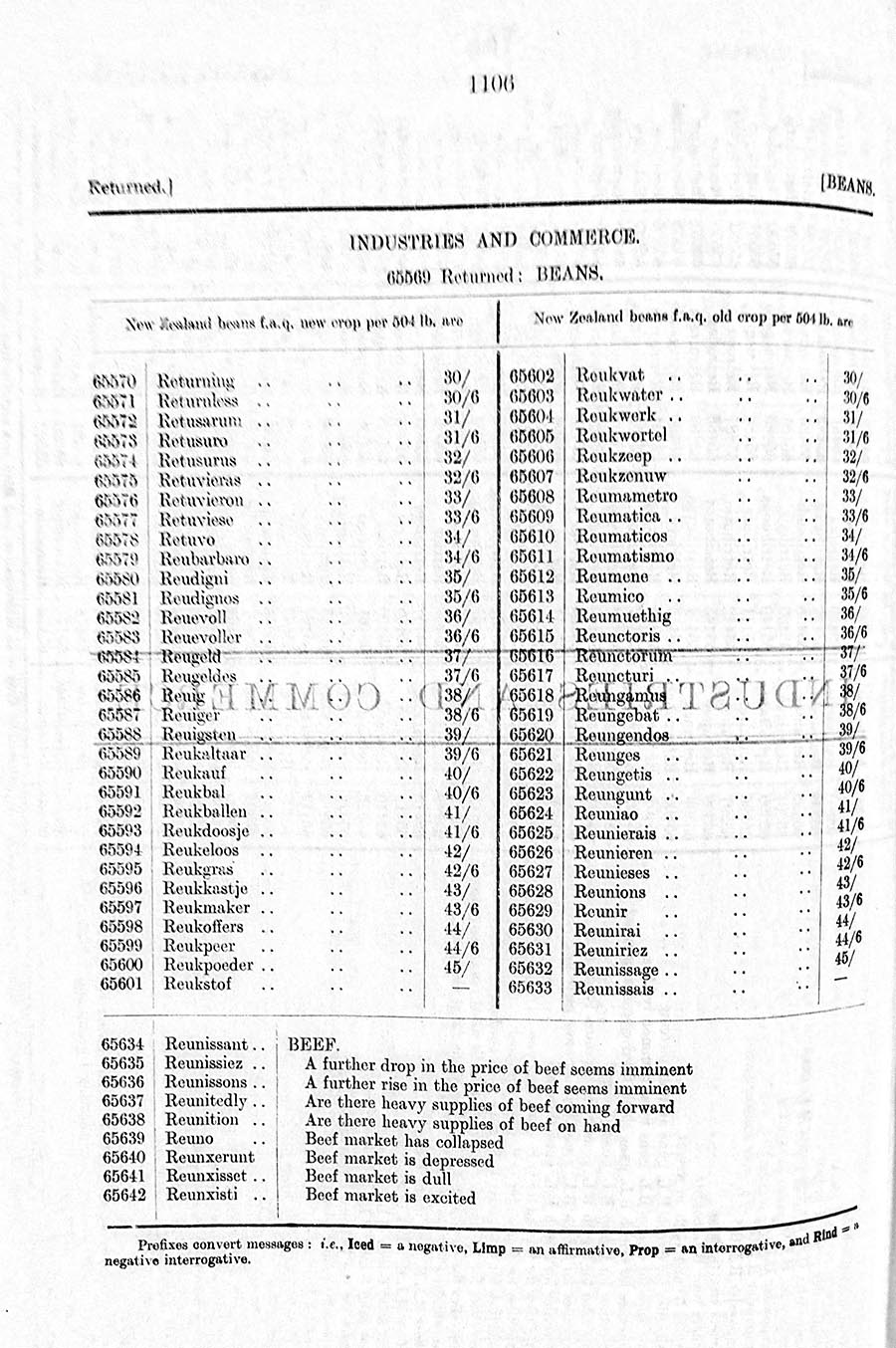 |
|
| page 1106, New Zealand Government Telegraph Code (1911) |
RL |
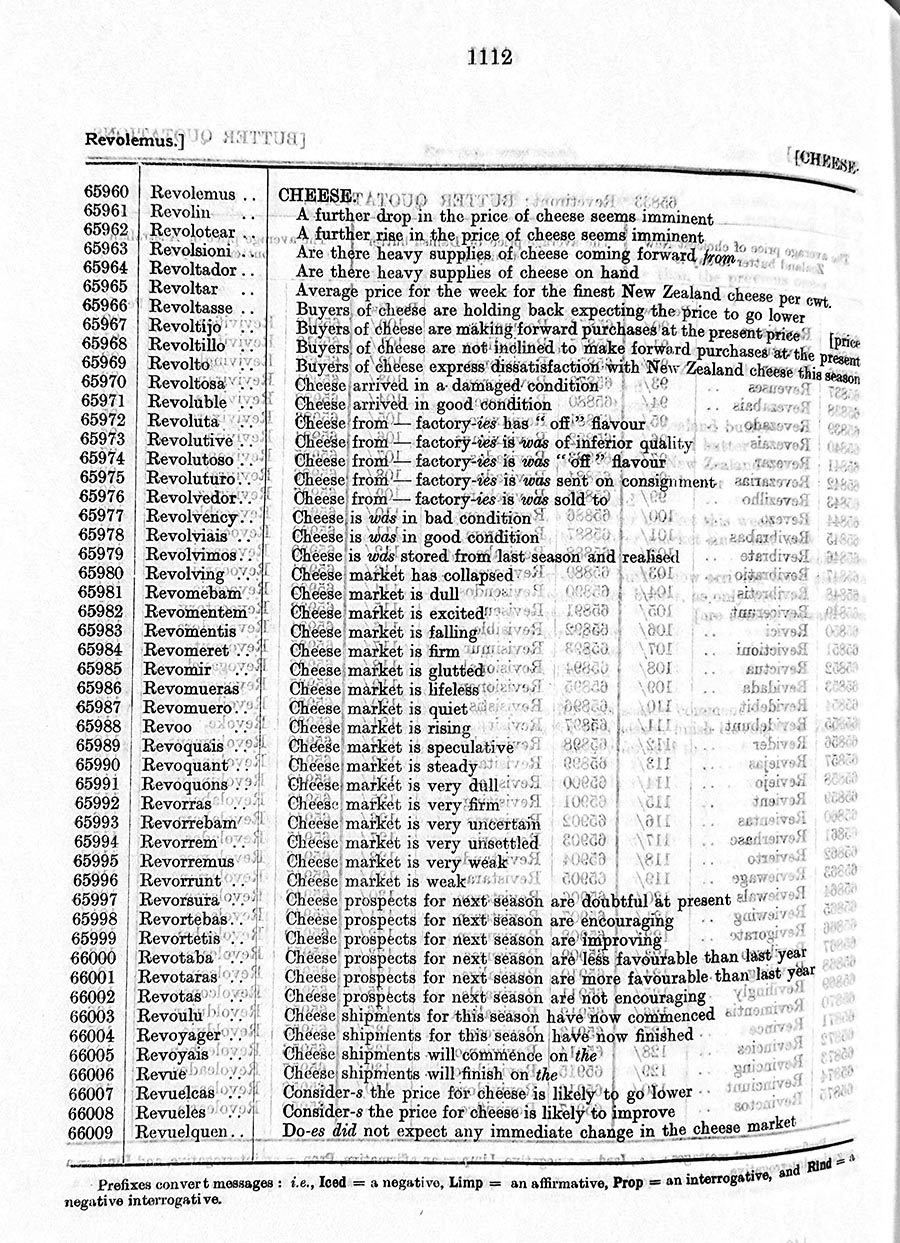 |
|
| page 1112, New Zealand Government Telegraph Code (1911) |
RL |
 |
|
| page 1138, New Zealand Government Telegraph Code (1911) |
RL |
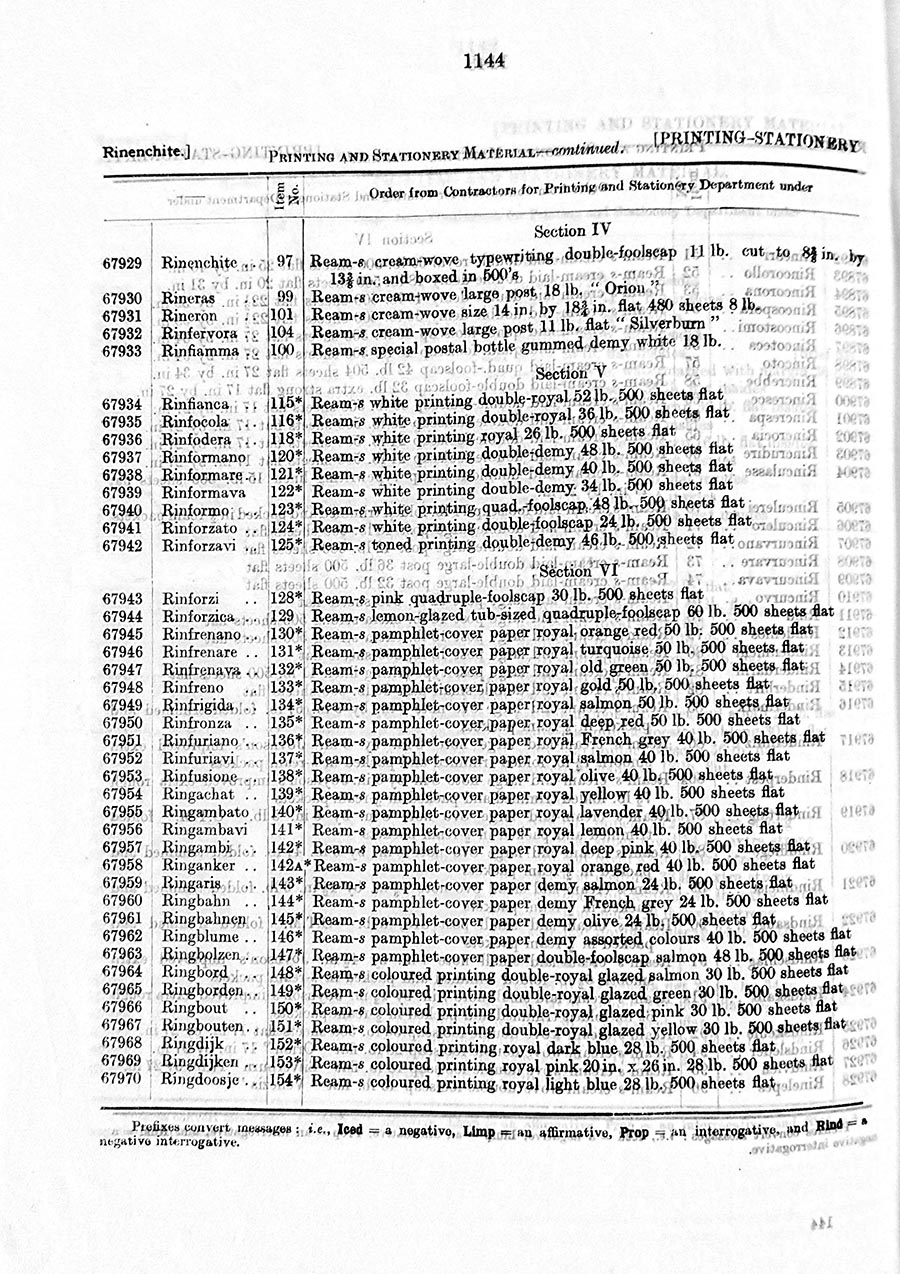 |
|
| page 1144, New Zealand Government Telegraph Code (1911) | RL |
| 1933 | Government Telegraph Code, 1933 | U.K., 1933 | private collection BL BS.31/263 |
| a five-letter code, phrases (their key words) in alphabetical order.
661 pages |
|||
The preface on page iii explains that (1) this edition meets requirements of the 1932 (Madrid) regulations, under which code language must not exceed five letters in length; (2) uses any combination of vowels and consonants, permitting "the arrangement of the groups in a consistent order on each page;" and (3) the code groups are "constructed on an arithmetical system" that ensures a two-letter difference, and "no two groups can contain the same five letters with one pair of letters inverted." Furthermore, (4), lists of ships and military units are printed as a separate appendix; and (5) 5-letter groups in this code must not be used in the address.
Table of Contents
Punctuation and amplifying phrases 2-3
Dictionary 4-587
Numbers 588-611
References to telegrams 612-621
References to despatches 622-631
References to dated telegrams 632-635
References to dated despatches 636-639
References to timed messages 640-651
References to indent or demand numbers 652-660
Spelling indicating groups 660
Spelling table [to be used after "indicating group""] 661
Appendix I. Part I [amendments, vessels, units]
Part II [list of holders and telegraphic addresses]
Appendix —
The Appendix was replaced at least four times (judging from what is stated in the appendices in the two copies in my collection).
My "weathered" copy contains a 132-page Appendix dated 1958 ("To be brought into use on 1st September, 1959 in replacement of Appendix (1951)."
The cleaner copy has a 130-page Appendix dated 1938 (to replace the Appendix of 1935), together with a single typewritten (both sides) sheet being "Addenda and Corrigenda" to the Appendix 1951 (which is not present); the sheet also has some handwritten notes in pen, and (in pencil) the location “Stockholm.”
Thus, the appendix appeared in different states in 1933 (the original date of publication), 1935, 1951, and 1959. There may, of course, have been more.
Specimen page spreads shown below.
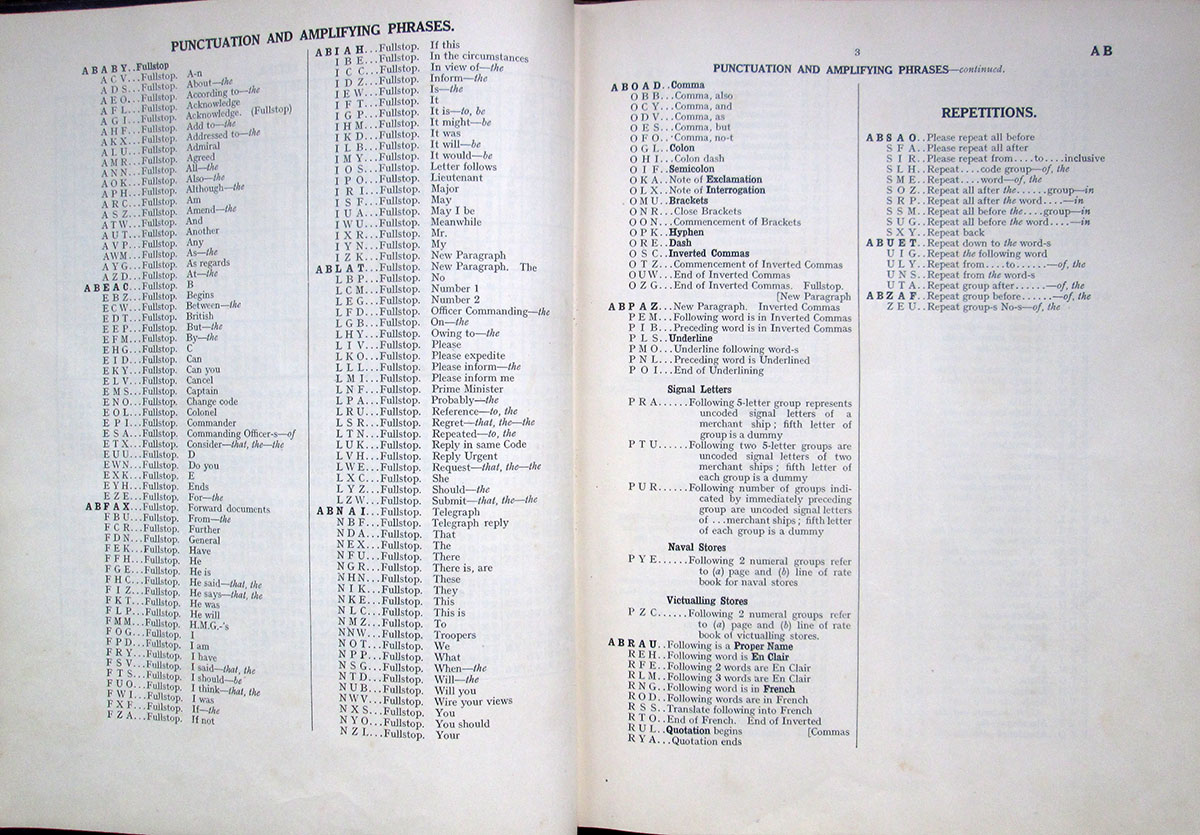 |
|
| pages 2-3, (U.K.) Government Telegraph Code, 1933 |
private collection |
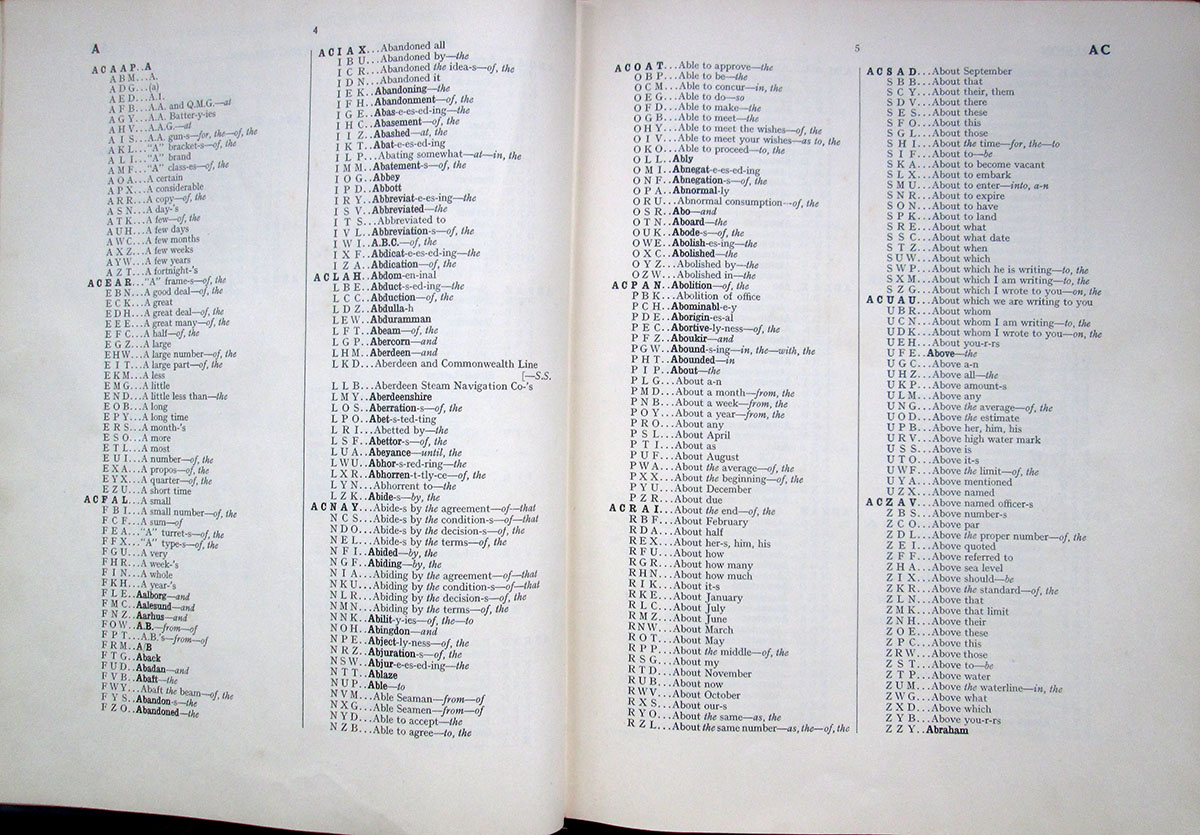 |
|
| pages 4-5, (U.K.) Government Telegraph Code, 1933 |
private collection |
 |
|
| pages 384-385, (U.K.) Government Telegraph Code, 1933 |
private collection |
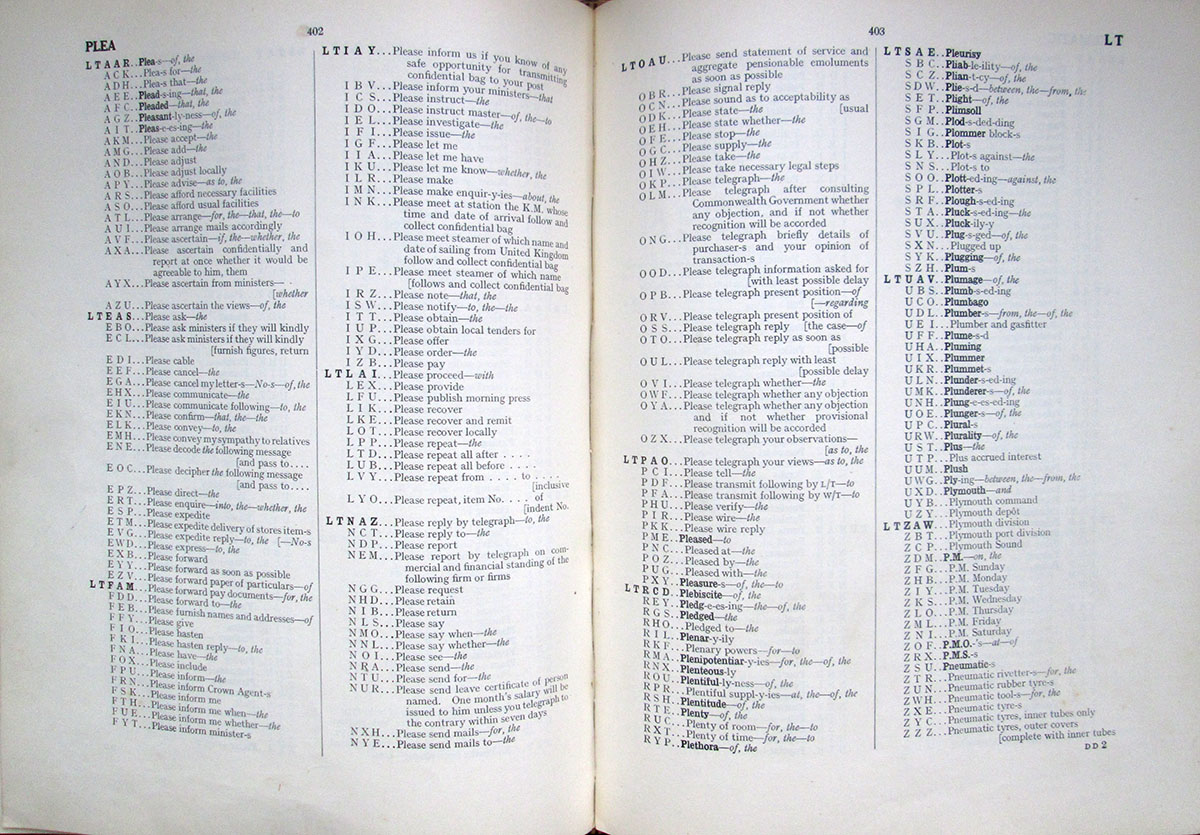 |
|
| pages 402-403, (U.K.) Government Telegraph Code, 1933 |
private collection |
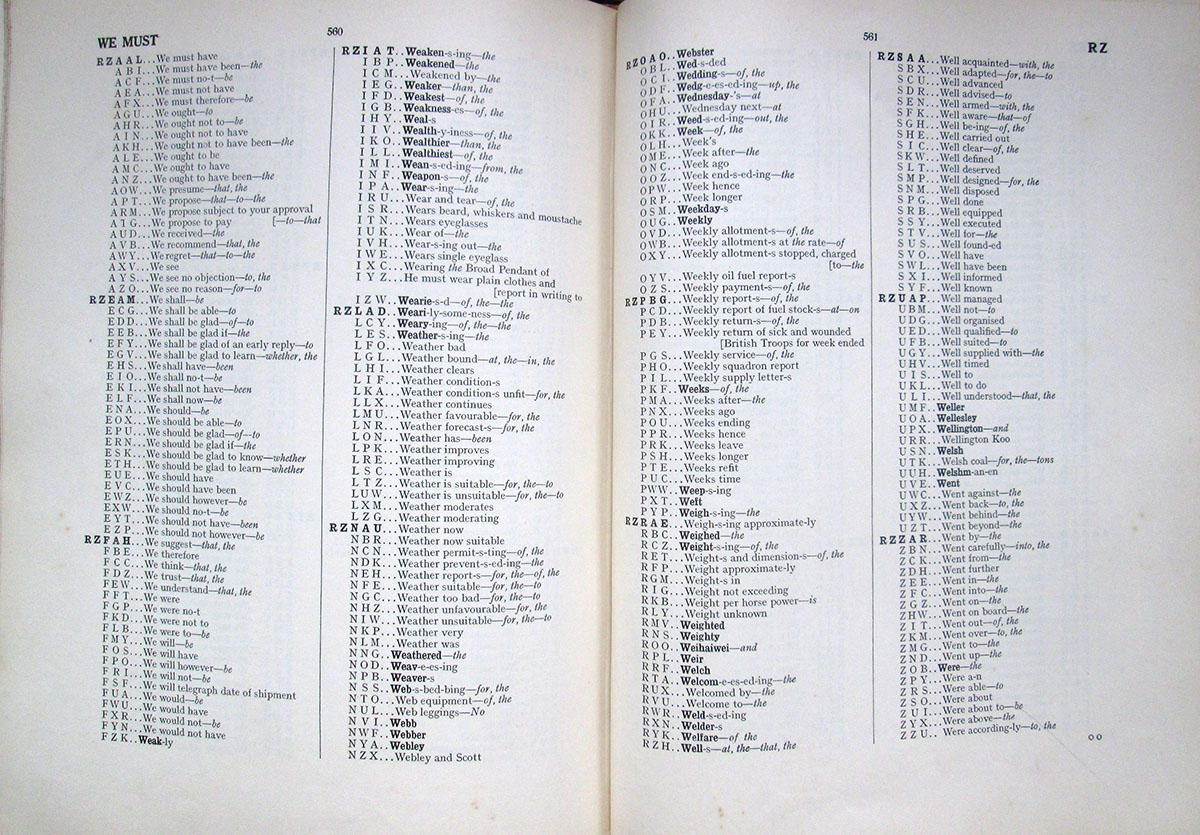 |
|
| pages 560-561, (U.K.) Government Telegraph Code, 1933 |
private collection |